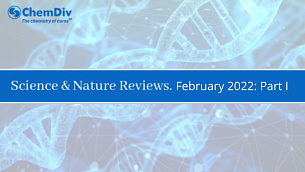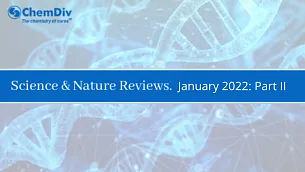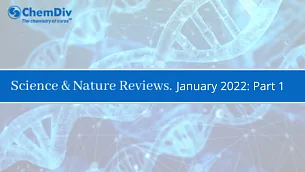Science & Nature Reviews, December 2021

ChemDiv shares reviews on Nature and Science Journal articles that we found the most exciting this month. Today we observe Stem cell therapy, Neurophysiology, Physiology, COVID-19, and Molecular biology.
Stem cell therapy
Hoste, E. Stem cells remember insults. Science, 374, 6571, (1052-1053), (2021)
Stem cells serve as a repair system for the body due to their ability to develop into many different types of cells in the body. Tissue stem cells respond to injury that induces radical changes in the microenvironment triggering stem cells to undergo a multitude of experiences. In new research, scientists showed that stem cells accumulate memories of diverse environmental events. Then immigrant stem cells look like native ones, however, chromatin changes in these stem cells are maintained long term. They may be of interest to medicine because such sells equip the skin with faster and broadened regenerative properties upon a secondary insult.
Neurophysiology
Krot, M., Rolls, A. Autoimmunity in neurodegeneration. Science, 374, 6569, (823-824), (2021)
Dementia is a general term for loss of memory, language, problem-solving and other thinking abilities. One of the most prevalent forms of this disease is Lewy body dementia, associated with abnormal deposits, called Lewy bodies, in the brain. Unfortunately, existing therapies are ineffective. But scientists found out that our immune system, especially T cells, is involved in the pathogenesis of this disease. Analysis revealed that T cells traffic to the LBD brain and are associated with neuronal damage. So, a specific signaling axis that induces this type of T cell trafficking to the central nervous system could be a therapeutic target for Lewy body dementia.
Physiology
Harris, N., Wickramasinghe, L. et al. A helminth-induced antimicrobial protein. Science, 374, 6568, (682-683), (2021).
Human organisms contain a mechanism within the host to rapidly kill and neutralize infectious microbes that breach barrier tissues, including the skin, lungs, and intestines, and antimicrobial proteins are the main part of this system. On pages of “Science” researchers identify small proline-rich protein 2A (SPRR2A). This protein is phylogenetically distinct from all other antimicrobial proteins. It protects against the bacterial invasion and dissemination that follow helminth infection. So, SPRR2A maintains intestinal barrier integrity during homeostasis and has the potential to be an effective therapeutic agent.
COVID-19
Saito, A., Irie, T., Suzuki, R. et al. Enhanced fusogenicity and pathogenicity of SARS-CoV-2 Delta P681R mutation. Nature (2021)
The topic of COVID-19 was raised in the new issue of “Nature”. It is known that the virus constantly mutates, forming new variants. Currently, four variants of concern are considered potentially hazardous to human society, including the recently emerged Delta. Researchers figured out its virological properties and show that the Delta variant is highly fusogenic and notably more pathogenic than prototypic SARS-CoV-2 due to the distinctive mutations of this variant. Understanding the mechanisms and structures of these mutations can help develop more effective treatments.
Molecular biology
Hung, K.L., Yost, K.E., Xie, L. et al. ecDNA hubs drive cooperative intermolecular oncogene expression. Nature 600, 731–736 (2021)
An oncogene is a mutated gene that contributes to the development of cancer. They allow the mutated cell to divide indefinitely, thus forming a tumor. Extrachromosomal DNA mediates high expression of oncogenes. In new research, scientists show mechanisms of oncogene overexpression. Extrachromosomal DNA hubs — clusters of around 10–100 of these molecules— enable intermolecular interactions to promote this process. Extrachromosomal DNA form hubs in diverse cancer cell types and primary tumors. So, this structure of DNA and protein may serve as potential targets for cancer therapy.
Reviewed by Maria Golubenko
Stem cell therapy
Hoste, E. Stem cells remember insults. Science, 374, 6571, (1052-1053), (2021)
Stem cells serve as a repair system for the body due to their ability to develop into many different types of cells in the body. Tissue stem cells respond to injury that induces radical changes in the microenvironment triggering stem cells to undergo a multitude of experiences. In new research, scientists showed that stem cells accumulate memories of diverse environmental events. Then immigrant stem cells look like native ones, however, chromatin changes in these stem cells are maintained long term. They may be of interest to medicine because such sells equip the skin with faster and broadened regenerative properties upon a secondary insult.
Neurophysiology
Krot, M., Rolls, A. Autoimmunity in neurodegeneration. Science, 374, 6569, (823-824), (2021)
Dementia is a general term for loss of memory, language, problem-solving and other thinking abilities. One of the most prevalent forms of this disease is Lewy body dementia, associated with abnormal deposits, called Lewy bodies, in the brain. Unfortunately, existing therapies are ineffective. But scientists found out that our immune system, especially T cells, is involved in the pathogenesis of this disease. Analysis revealed that T cells traffic to the LBD brain and are associated with neuronal damage. So, a specific signaling axis that induces this type of T cell trafficking to the central nervous system could be a therapeutic target for Lewy body dementia.
Physiology
Harris, N., Wickramasinghe, L. et al. A helminth-induced antimicrobial protein. Science, 374, 6568, (682-683), (2021).
Human organisms contain a mechanism within the host to rapidly kill and neutralize infectious microbes that breach barrier tissues, including the skin, lungs, and intestines, and antimicrobial proteins are the main part of this system. On pages of “Science” researchers identify small proline-rich protein 2A (SPRR2A). This protein is phylogenetically distinct from all other antimicrobial proteins. It protects against the bacterial invasion and dissemination that follow helminth infection. So, SPRR2A maintains intestinal barrier integrity during homeostasis and has the potential to be an effective therapeutic agent.
COVID-19
Saito, A., Irie, T., Suzuki, R. et al. Enhanced fusogenicity and pathogenicity of SARS-CoV-2 Delta P681R mutation. Nature (2021)
The topic of COVID-19 was raised in the new issue of “Nature”. It is known that the virus constantly mutates, forming new variants. Currently, four variants of concern are considered potentially hazardous to human society, including the recently emerged Delta. Researchers figured out its virological properties and show that the Delta variant is highly fusogenic and notably more pathogenic than prototypic SARS-CoV-2 due to the distinctive mutations of this variant. Understanding the mechanisms and structures of these mutations can help develop more effective treatments.
Molecular biology
Hung, K.L., Yost, K.E., Xie, L. et al. ecDNA hubs drive cooperative intermolecular oncogene expression. Nature 600, 731–736 (2021)
An oncogene is a mutated gene that contributes to the development of cancer. They allow the mutated cell to divide indefinitely, thus forming a tumor. Extrachromosomal DNA mediates high expression of oncogenes. In new research, scientists show mechanisms of oncogene overexpression. Extrachromosomal DNA hubs — clusters of around 10–100 of these molecules— enable intermolecular interactions to promote this process. Extrachromosomal DNA form hubs in diverse cancer cell types and primary tumors. So, this structure of DNA and protein may serve as potential targets for cancer therapy.
Reviewed by Maria Golubenko



